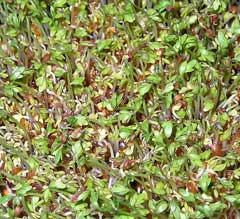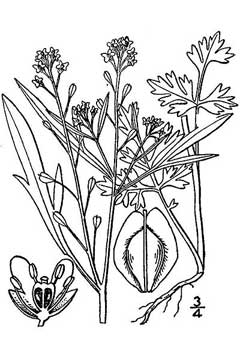 |
|
http://commons.wikimedia.org/wiki/User:Vdegroot |
 |
| USDA-NRCS PLANTS Database / Britton, N.L., and A. Brown. 1913. Illustrated flora of the northern states and Canada. Vol. 2: 166. |
Translate this page:
Summary
Physical Characteristics

 Lepidium sativum is a ANNUAL growing to 0.5 m (1ft 8in).
Lepidium sativum is a ANNUAL growing to 0.5 m (1ft 8in).
See above for USDA hardiness. It is hardy to UK zone 7. It is in flower from June to July, and the seeds ripen from July to August. The species is hermaphrodite (has both male and female organs) and is pollinated by Insects.
Suitable for: light (sandy), medium (loamy) and heavy (clay) soils. Suitable pH: mildly acid, neutral and basic (mildly alkaline) soils. It can grow in semi-shade (light woodland) or no shade. It prefers moist soil.
UK Hardiness Map
US Hardiness Map
Synonyms
Plant Habitats
Cultivated Beds;
Edible Uses
Edible Parts: Leaves Oil Oil Shoots
Edible Uses: Condiment Oil Oil
Young leaves - raw or cooked[2, 5, 27, 34, 52, 183]. A hot cress-like flavour, it makes an excellent addition (in small quantities) to the salad bowl[K]. An analysis is available. Root is used as a condiment[46, 61]. A hot pungent flavour, but the root is rather small and woody[K]. The fresh or dried seedpods can be used as a pungent seasoning[183]. The seed can be sprouted in relatively low light until the shoots are a few centimetres long and then be used in salads[183]. They take about 7 days to be ready and have a pleasantly hot flavour. An edible oil is obtained from the seed[46, 61, 105].
References More on Edible Uses
| Composition
|
| Figures in grams (g) or miligrams (mg) per 100g of food.
|
|
|
Leaves (Fresh weight)
|
|
- 0 Calories per 100g
- Water : 82.3%
- Protein: 5.8g; Fat: 1g; Carbohydrate: 8.7g; Fibre: 0g; Ash: 0g;
- Minerals - Calcium: 0mg; Phosphorus: 0mg; Iron: 28.6mg; Magnesium: 0mg; Sodium: 0mg; Potassium: 0mg; Zinc: 0mg;
- Vitamins - A: 2970mg; Thiamine (B1): 0.11mg; Riboflavin (B2): 0.17mg; Niacin: 1mg; B6: 0mg; C: 87mg;
- Reference: [ 240]
- Notes:
|
|
Medicinal Uses
Plants For A Future can not take any responsibility for any adverse effects from the use of plants. Always seek advice from a professional before using a plant medicinally.
Antiasthmatic Antiscorbutic Aperient Diuretic Galactogogue Poultice Stimulant Vitamin C
The leaves are antiscorbutic, diuretic and stimulant[46, 240]. The plant is administered in cases of asthma, cough with expectoration and bleeding piles[240]. The root is used in the treatment of secondary syphilis and tenesmus[240]. The seeds are galactogogue. They have been boiled with milk and used to procure an abortion, they have been applied as a poultice to pains and hurts and have also been used as an aperient[240]. Fresh foliage has 37% Ascorbic acid - vitamin C
References More on Medicinal Uses
The Bookshop: Edible Plant Books
Our Latest books on Perennial Plants For Food Forests and Permaculture Gardens in paperback or digital formats.

Edible Tropical Plants
Food Forest Plants for Hotter Conditions: 250+ Plants For Tropical Food Forests & Permaculture Gardens.
More

Edible Temperate Plants
Plants for Your Food Forest: 500 Plants for Temperate Food Forests & Permaculture Gardens.
More

More Books
PFAF have eight books available in paperback and digital formats. Browse the shop for more information.
Shop Now
Other Uses
Oil Oil
The seed yields up to 58% of an edible oil that can also be used for lighting[74].
Special Uses
References More on Other Uses
Cultivation details
An easily grown plant, it succeeds in most soils[52]. For the best results, however, it requires a moist soil and also some shade during the summer to prevent it running straight to seed[27, 37, 52]. Garden cress is often cultivated as a sprouted seed, there are some named varieties[183]. It is the cress of 'mustard and cress'. A very easy and fast crop, it can be ready within 7 days from sowing the seed[27]. It can also be grown outdoors as full grown plants and can provide fresh leaves for the salad bowl all year round from successional sowings. Plants can be overwintered outdoors to provide edible leaves all year round, though they will require some protection if temperatures fall below -5°c[200]. This plant is cultivated in Ethiopia for the edible oil from its seed[183].
References Carbon Farming Information and Carbon Sequestration Information
Temperature Converter
Type a value in the Celsius field to convert the value to Fahrenheit:
Fahrenheit:
The PFAF Bookshop
Plants For A Future have a number of books available in paperback and digital form. Book titles include Edible Plants, Edible Perennials, Edible Trees,Edible Shrubs, Woodland Gardening, and Temperate Food Forest Plants. Our new book is Food Forest Plants For Hotter Conditions (Tropical and Sub-Tropical).
Shop Now
Plant Propagation
Seed - if you want a succession of young leaves then it is possible to sow the seed in situ every 3 weeks in succession from early spring to early autumn. Germination is very rapid, usually taking place in less than a week. When sowing seed for use in mustard and cress, the seed is soaked for about 12 hours in warm water and then placed in a humid position. Traditionally, it is sown in a tray on a thin layer of soil, or on some moist blotting paper, and the tray is placed in a warm dark place for a few days to encourage rapid and rather etiolated growth. The seedlings can then be placed in a lighter position for a couple more days to turn green before being eaten. The cress seed should be sown about 3 - 4 days before the mustard for them both to be ready at the same time[264].
Other Names
If available other names are mentioned here
Native Range
TEMPERATE ASIA: United Arab Emirates, Kuwait, Oman, Saudi Arabia, Yemen, Afghanistan, Iran, Iraq, Israel, Jordan, Lebanon, Syria, Turkey TROPICAL ASIA: Pakistan AFRICA: Egypt, Ethiopia
Weed Potential
Right plant wrong place. We are currently updating this section.
Please note that a plant may be invasive in one area but may not in your area so it's worth checking.
Conservation Status
IUCN Red List of Threatened Plants Status :

Growth: S = slow M = medium F = fast. Soil: L = light (sandy) M = medium H = heavy (clay). pH: A = acid N = neutral B = basic (alkaline). Shade: F = full shade S = semi-shade N = no shade. Moisture: D = dry M = Moist We = wet Wa = water.
Now available:
Food Forest Plants for Mediterranean Conditions
350+ Perennial Plants For Mediterranean and Drier Food Forests and Permaculture Gardens.
[Paperback and eBook]
This is the third in Plants For A Future's series of plant guides for food forests tailored to
specific climate zones. Following volumes on temperate and tropical ecosystems, this book focuses
on species suited to Mediterranean conditions—regions with hot, dry summers and cool, wet winters,
often facing the added challenge of climate change.
Read More
Expert comment
Author
L.
Botanical References
17200
Links / References
For a list of references used on this page please go here
Readers comment
© 2010, Plants For A Future. Plants For A Future is a charitable company limited by guarantee, registered in England and Wales. Charity No. 1057719, Company No. 3204567.